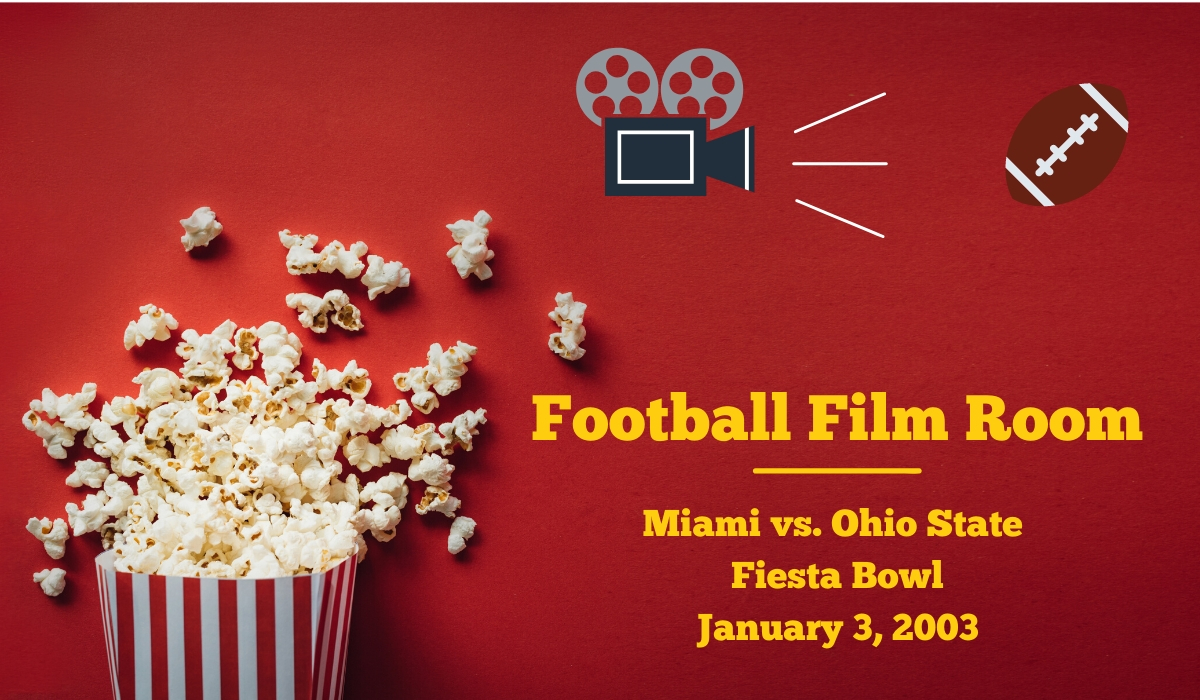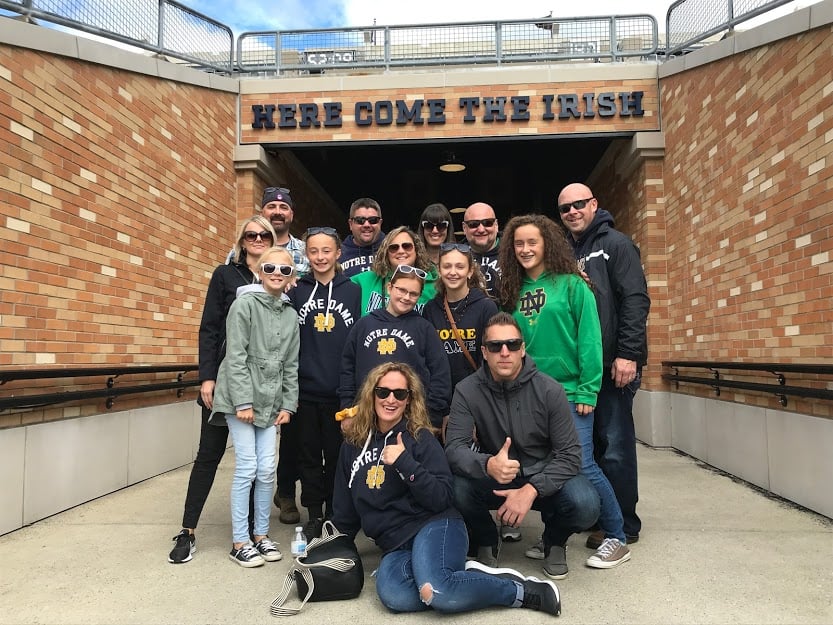Throughout the next month, we'll be deep-diving into some of the greatest college football games of all time. This week, we look back at the 2003 Fiesta Bowl, when Miami and OSU gave us an absolute classic, with a controversial ending people are still talking about...
Miami vs. Ohio State
Fiesta Bowl
January 3, 2003
Ohio State: 31 | Miami: 24
There are two kinds of “unforgettable” when it comes to football games.
The first is the one that’s the slow burn. The one where you realize - perhaps somewhere between a key turnover in the third quarter or maybe just before a game-winning two minute drill in the fourth - that you’re watching something special.
But the other? The other is the kind of game where you know even before it’s kicked off. When there’s just something in the stadium’s atmosphere as the two teams get ready to take the field - and from beginning to end, you can just feel it: you’re never going to forget this game.
Miami and Ohio State’s meeting 17 years ago was firmly in the second camp.
It had a little bit of everything: oodles of star power filling the rosters on two blue blood programs, back-and-forth action, multiple controversies that still get argued about all these years later - and, of course, a national champion crowned.
Our Football Film Room series continues, as we take you back to Tempe, Arizona for the Fiesta Bowl - January 3, 2003.
Where our story begins…
It’s hard to put into words just how dominant the Miami Hurricanes were in the early 2000s.
By the time they met the Buckeyes in the 2003 national championship, the ‘Canes had won 34 straight games dating back to September of 2000. And while the BCS system didn’t give them a chance at the national championship game at the end of the 2000-2001 season (and, I imagine, because of it), Miami didn’t leave anything to chance in the 2001-2002 season en route to a 12-0 record and a national championship after they topped Nebraska in the Rose Bowl.
When the 2002-2003 season kicked off, head coach Larry Coker had, without question, the team-to-beat in college football, even withstanding that they would have to replace 11 NFL draft picks from the roster that, in 2014, FiveThirtyEight called the most talented team in college football history.
You’d be forgiven, however, for forgetting that this team seemed to be missing anything at all... because on paper, they weren’t.
Miami boasted weapons at virtually every position. I mean, look at these names: QB Ken Dorsey (38-1 as a starter coming into this game), Andre Johnson at receiver, Kellen Winslow Jr, at the TE. There was Sean Taylor, Antrel Rolle, Jonathan Vilma on defense. And all of this without even mentioning Willis McGahee in the backfield, whose 2,000 yards from scrimmage and 28 rushing touchdowns made him - even amongst all this talent - the player to watch when this game kicked off.
Miami all-but-waltzed through the regular season, their lone close call coming in a game to rival Florida State, where a potential game-winning field goal from the ‘Noles missed wide left.
Ohio State, on the other hand, had lived and died by close calls throughout the 2002 season.
They edged out Cincinnati by just four points, Wisconsin by five, needed a last second prayer to Michael Jenkins at Purdue, went into overtime against Illinois, and then saved their season on a critical interception against Michigan as the Wolverines marched towards the endzone late in the game.
And yet, when it was all said and done, the Buckeyes sat at 13-0, the most wins in the school’s history up to that point - and with talent enough to make things more difficult for the Hurricanes than any team had up to that point.
Ohio State’s defense was the key, and is among the best units college football has ever seen - particularly up front. Leaving aside a flukey Texas Tech touchdown during a week one blowout, not a single opponent had scored 20 on the Buckeyes heading into this game. They were led by Will Smith and Tim Anderson up front, who helped anchor a rushing defense that was mind-boggling - allowing just 78.4 yards per game and four rushing touchdowns all season. But that didn’t mean the secondary was anything to sneeze at; Mike Doss and Will Allen were two of the country’s best talents at safety, while the move to shift Cie Grant from cornerback to linebacker paid off all year long. Offensive star Chris Gamble would step in at corner and was an immediate force - with four interceptions to go with his 31 offensive receptions.
If there was a weakness for Ohio State, it was simply that their offense wasn’t quite as good as their defense - though obviously, that’s hardly something to hold against them. And besides, Ohio State was far from deficient offensively.
Outside of Gamble, they had a solid QB in Craig Krenzel, Gamble and Jenkins both as big play threats at the receiving position, and, of course, a true freshman named Maurice Clarett in the backfield, whose 1,237 yards and 16 rushing touchdowns redefined what most thought possible for a first year player in college football.
The two teams represented the last undefeated teams left standing by the end of the 2002 season, but of course, only one could retain the title by the time the final whistle blew...
How it all happened
Even as both teams stalled on their opening drives, we knew one thing right away: Miami’s offense may have dominated with their speed in 2002, but Ohio State’s defense wasn’t about to lose for lack of athleticism.
Even amidst Miami’s first touchdown drive to open the scoring midway through the first quarter - Smith and Anderson still were absolutely relentless in their pursuit to the backfield. They dropped Dorsey for sacks, met McGahee in the backfield - and while the Hurricanes found some daylight on a touchdown pass to Roscoe Parish, that would be the last points Miami would score until midway through the third quarter.
Ohio State’s offense, meanwhile, took some time settling in. They got a few procedural penalties through the first quarter, Krenzel threw a pass that was intercepted by Sean Taylor, and had it not been for the tremendous play of the Buckeyes defense… who knows how this game would have looked.
Besides just not allowing Miami to score after that Parish touchdown, OSU also forced three turnovers in the first half - which the offense was able to wrestle in for 14 points, to go into halftime up seven points.
When the third quarter kicked off, the fireworks kept going, with Krenzel hitting Gamble on a huge pass down the sidelines which was almost fumbled… but Gamble was ruled down. This set up what would have been a would-be touchdown for the Buckeyes, but Sean Taylor picked off Krenzel again - this time in the endzone - and began to run it back the other way. Suddenly, Miami had the momentum back, and with a short field they were well within striking distance to tie this one back up, right?
Not so fast…
Maurice Clarett made what might be the second-most important play of the game, when he stripped Taylor and got the ball back for the Buckeyes. It was an absolute morale swing, and OSU would add three more points on the ensuing drive. Suddenly, the defending champions found themselves on the ropes.
The Canes, however, weren’t about to simply give up in Tempe. They quickly got the ball back and marched right back down the field for a 55 yard touchdown run capped by McGahee’s lone touchdown of the evening, getting the Canes right back in the ballgame 17-14. After another short drive for the Buckeyes ended in a punt, it looked as though Miami would be able to erase the deficit completely.
But then... disaster.
After McGahee caught a pass on the right side of the field, he was immediately hit low at the knee, and he stayed down after the dust settled. He wouldn’t return, and we’d later find out that McGahee had torn his ACL, MCL, and PCL, ending one of the most promising young college careers we’d ever seen. More on him in a moment.
While Miami’s offense stalled without McGahee, so too did Ohio State’s. They missed a field goal on their next drive, failed to convert points on Miami’s fifth (FIFTH!) turnover of the game after that - and thanks to a 50 yard punt return by Roscoe Parish, the Canes were still able to knock in the tying field goal… and we were going to overtime.
Somehow, that’s where things really got interesting. Miami started with the ball and quickly scored on five plays, but it was the next possession that would have people talking for the next two decades…
On 4th down, with just five yards to the endzone, Krenzel tossed the ball up to Gamble - but the pass fell incomplete. Time expired. Fans and players began to celebrate. Larry Coker even started running onto the field.
BUT NOT. SO. FAST.
A late flag for pass interference flew in on Glen Sharpe, giving the Buckeyes an automatic first down... and delivering an eternally heartbreaking moment for the Canes…
From there, the Buckeyes got into the endzone on a QB sneak from Krenzel, got the ball back for double overtime and promptly ran it in on a Clarett sidestep.
Then, it was once again the pressure that got Ken Dorsey on Miami’s next overtime drive, as his fourth down pass sailed incomplete with the Buckeyes’ defensive line bearing down on him.
31-24, OSU. Ballgame.
Instant reaction to the rewatch
Was it a pass interference though?
I’ve watched this play over and over again for this piece, and I’m ready to definitively say it: I don’t think this was pass interference. It’s a bang-bang play, for sure, but as you watch the ball, you can see that this just looks like excellent timing from Glen Sharpe; he arrives just as Gamble gets his hand on the ball, not before.
That’s my feeling, and I’m sticking to it.
Now, that said, bad calls are a part of sports - and I think that this is hardly as egregious as, say, the Rams/Saints missed pass interference call in 2018. There’s a reason this has been as hotly contested as it has been; it was incredibly close. But ultimately it just doesn’t look like he impedes him enough to get the call, certainly not a call to decide the National Championship.
This wasn’t the only questionable call in this game
That pass interference call wasn’t the only thing questionable about this game - far from it.
Two plays in the third quarter that went the right way for the Buckeyes could have swung the game. First, Gamble nearly fumbling at the six-yard-line on the 57 yard pass from Krenzel. Now, I don’t have a huge bone to pick here, because we didn’t get tons of replays. What I do know, is that in real time… boy did it look like he fumbled.
And then! A few plays later when Clarett stripped the ball from Taylor on the interception… look, this was an amazing play by Clarett, and I always want to reward hustle. But on the replay, I don’t know that I can definitively say Clarett had that ball. And without that play, the Buckeyes don’t get the extra three points that Miami needs to tie up…
But before you go calling me a conspiracy theorist, it also has to be noted that Ohio State had a key call go against them later in the game, when on a third down with just two minutes to go in regulation, Gamble made what looked like an incredible catch on the sideline… only to have it called incomplete. That incompletion forced the Buckeyes to punt, setting Miami up to tie the ballgame and send it to overtime in the first place.
Maurice Clarett is the MVP
Clarett had better statlines than his 23 carries for just 47 yards (I was reminded doing research for this game that he put up 175 yards and three touchdowns in his first college game), but when it was all said and done - he made the plays that meant the most.
His strip on Taylor (controversial though it was) led to what could have been as much as a 10-point swing, and as he got into the endzone in double OT, it felt right that the game-winner should belong to him.
Clarett may have been the MVP, but was Roscoe Parish the x-factor for the Hurricanes?
On a team with so much talent, Roscoe Parish’s 270 yards and one touchdown during the regular season may have been thought of as an afterthought heading into this one.
But Parish, then in his first year at Miami, had easily the best game of his young career - getting the opening touchdown, recording a career high in catches (five), and adding that huge 50 yard punt return to set up the game-tying field goal for the Hurricanes at the end of regulation.
Boy did Krenzel have a rough game
As far as “National Championship-winning” performances go, Craig Krenzel’s 7-21 passing for just 122 yards, no touchdowns, and two interceptions for a final QB rating of 63.1 is among as statistically bad as you can imagine.
Still, as they say, whatever gets it done.
What’s stood the test of time
Instant replay in football
This one feels pretty self-explanatory at this stage in the post.
The number of challengeable calls in this game felt… countless. And if you opened it up to allowing coaches to challenge pass interference calls? This one likely ends up going the other way.
The Willis McGahee comeback story
When Willis McGahee went down in the fourth quarter and the diagnosis came out, there were more than a few pundits who said that while he would no doubt get a shot in the NFL, he would never live up to the expectations we had for him going into the league.
And while no, he didn’t become the next Walter Payton, McGahee spent a fantastic pro career proving those pundits wrong: 95 starts, 8,474 yards (including three 1,000+ yard rushing seasons), 65 rushing TDs, and two Pro Bowl selections over 10 years in the NFL.
We’ll never know what could have been if that hit had never happened in the Fiesta Bowl, but to me, it’s not useful to dwell on it - McGahee fought back to rewrite his own finish, and that’s worth celebrating.
This as a TRUE National Championship game
There are certainly arguments to be made about which call mattered for which team, and who might have won the game had the ball bounced a certain way - but one thing that’s not in doubt is that this was one of the years in which the BCS gave us a true national champion.
And in case you don’t remember, that didn’t happen all the time!
Remember how in 2001 Oregon was undefeated but got passed over for Nebraska, who went on to lose to Miami in that Rose Bowl? Remember USC ending the season as the number one team in the country, but having to settle for facing #4 Michigan? Remember how angry Group of Six teams get when they go undefeated but still are left out of top tier postseason play? (Some things never change, folks).
But this was one of those rare years that it all worked out like it was supposed to; the last two undefeated teams entered, and only one left Tempe with a perfect record still intact.
Why this game?
I remembered the pass interference call - as, I imagine, most of you did, as well.
But there’s so much more in the subtext of this game: Miami’s 34-game winning streak, Jim Tressel in just his second season at Ohio State, Maurice Clarett, McGahee, all of the NFL talent - like I said at the beginning, this is just one of those games that felt big from the opening kickoff.
This was also arguably the last great Miami team we’d see. They would finish 11-2 the following year, adding a win in the Orange Bowl over Florida State to land themselves 5th in the postseason AP ranking, but since then they’ve never finished the season in the top 10. Nearly two decades later, it’s hard to remember just how big this team was during this period of time without going back and watching these games.
And for Ohio State? It would open an era in Ohio State football under Tressel that, while prosperous, would end in disappointment after scandal forced him out in 2011.
It was the beginning of so much, the end of so much - and if this game didn’t convince you the refs needed a little bit of help from the replay booth, I don’t know what to tell you.
Did we miss something? Let me know! Email hank@rentlikeachampion.com and give your thoughts on this absolute classic, and keep following along with our Football Film Room series!




.jpg)
.jpg)
